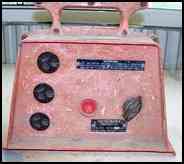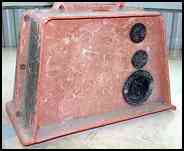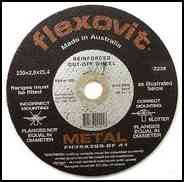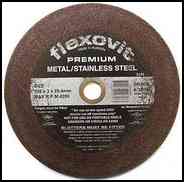 |
||||||||||||
Power tool safetyPower tool safety all boils down to you. You are the major factor in your own safety. Keep alert and think about what you are doing and you'll be fine. If you feel sick or exhausted have a rest. If you wanna jig about and listen to your iPod, make a choice, one or the other. You should be concentrating on what you are doing when using power tools.
IntroductionI use the term power tool in the sense of anything that runs off an ordinary household power point, usually hand held, able to be carried about easily, but it could also be something heavier like a saw that is more often found in a workshop but could be set up on a temporary bench in a home DIY situation. Below are a few general notes on power tool safety. All fairly obvious but it never does any harm to restate them. Even small tools like a drill used for a 5 minute DIY job can cause a bit of strife. At the same time, don't let any of the warnings put you off enjoying what can be a very satisfying experience.
For example, Bazza was using cyclone screws (14G tek screws with a big washer bent to the roofing iron profile) to screw his roof down early one morning, he was adjusting the washer and screwed his finger down, "ahhh! shit" he yelled (as you do) and let go of the screwdriver gun, which slid down the roof out of his reach. Two hours later, much relieved but very embarrassed, somebody unscrewed him. A funny story which gets told a lot, but if Bazza had been working on the last row at the edge of the roof he could have fell off and been really injured.
Safety Boxes, ELD, RCDWe are always working with power leads. When I am using power tools, I try to always use an ELD, (earth leakage detector) safety box, or RCD, (residual current device). There are a few different types but they all are designed to cut off the power supply in a fraction of a second when a fault happens. The one pictured here has one input socket and five output ones. It is rated at 15amps and has a sensitivity of 20 m.A. Even when there is already one in the household supply I still use my portable one as well. This is my number one back up in case something goes wrong. I check it two or three times every time I plug it in. That is, press the test switch and reset. Electric tool safety has been greatly improved by the use of these devices. Where I live, all houses built recently have an Earth leakage Detector built into the house switchboard. It is mandatory. ELD's are also mandatory for building site temporary power supplies. It is mandatory on building sites for all electric power cords and electric power tools, to be checked and tagged by a licensed electrician. None of us I guess are over fond of government regulation, but these ELD,RCD, earth leakage detector ones make good sense. Look after your leads and always use your "Jesus Box" (as one of my roofing mates calls it.)The theory of them is simple, if a fault occurs in either the tool you are using or the lead to it, the box will trip out, disconnecting the power in 30 milliseconds or less. A lot quicker than the average circuit breaker.
This old dinosaur is one of the first to come on the market, and is still doing the same job I bought it for. It is a Heinman EP12, 15amps rated with a sensitivity of 20 M.A. The warning says TEST UNIT BEFORE ANY TOOL IS CONNECTED. IF UNIT DOES NOT TRIP, A DANGEROUS CONDITION MAY EXIST DUE TO A FAULT IN THE LEADS, SUPPLY OUTLETS, OR THE UNIT ITSELF. As soon as I plug it in I always press the red test button a few times and reset it to make sure it is in top form. ALWAYS. This particular one has cut out a few times for real. Usually damaged leads or loose wiring in the power tool switch. On one occasion it kept cutting out when plugged into a faulty circuit in an existing house we were extending. This prompted an electrical check of the whole house and a few other faults were found and corrected. A new ELD was also fitted into the house' main switchboard. Don't use one of these and think you are bulletproof. Still use common sense in all your working with tools.On a few occasions I have had a distinct tingling sensation when screwing off a roof in hot and humid conditions and sweat has run down my hand and around the screwdriver gun. The box did not trip as I thought it should. Not a pleasant experience. If anybody can explain this I'd be glad to hear from you. Double insulated tools are not protected by an ELD. These are usually plastic bodied small tools with no earth prong. They are safer electrically than a standard tool without ELD protection. Watch The RPMDon't EVER dream of putting a tool designed for a slow speed tool into a high speed tool. Like a paint stirrer that should be in an electric drill, into a router. (Don't laugh, I've seen it done), and it was a tradesman, not a DIY-er that did it.
Always match the blade, disk, cutter etc. to the tools you are putting it into. Friction disks, grinding wheels, etc usually have warnings on them about the correct mounting and the Max. RPM. for them to be used at. Take heed. If the blade is over revved or wrongly mounted it could shatter. NEVER go over the maximum RPM....... NEVER. These two disks are just about the same size, both for metal with same centre hole. One Is rated at Max 6800 RPM and can safely be used in my large angle grinder which has a max RPM of 6600. The other one has been used in my steel cut off saw. It is rated at 4200 RPM . If I didn't read the label and used it in the grinder by mistake, it could shatter. I get quite a few leftovers like this when I am cutting say, RHS (rectangular hollow section) that, as the blade wears down, it will not longer cut all the way through in one hit. I am never tempted to use them up in the grinder. I can and do use them in my large power saw, rated at 4100 RPM, that I have kept aside for cutting metal.
Remember, the most cost effective tools you can buy are safety tools. Think about it. A chop saw will save you money cutting steel , rather than paying someone else to do it. A face mask or visor could save you a trip to hospital..........!
Not found it yet? Try this FAST SITE SEARCH or the whole web |
Hire Equipment  Furniture Fittings - Architectural Hardware - Electronic Locking Systems - Technical Hardware BuilderBill sponsorship Power tool related pages
I was once cutting some steel with a cutting disk in a 235 angle grinder, I felt a bit warm as sparks were hitting my leg and I distinctly remember saying to myself "go on you weak b.....d, finish the cut!". I didn't! My shorts burst into flame and before I had the flames out I had holes in my underpants too. The stupid thing about it was I had a leather apron in my trailer...but, it was a hot day...I was only doing a quick job... USE YOUR PROTECTIVE GEAR. Goggles, gloves, ear muffs, boots etc.
|
|||||||||||
|
|
||||||||||||
|
Please Note! The information on this site is offered as a guide only! When we are talking about areas where building regulations or safety regulations could exist,the information here could be wrong for your area. It could be out of date! Regulations breed faster than rabbits! You must check your own local conditions. Copyright © Bill Bradley 2007-2012. All rights reserved. |
||||||||||||



